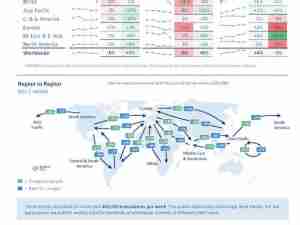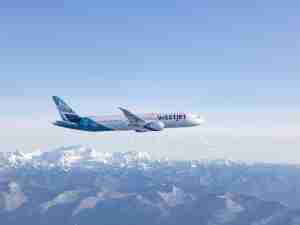Air India’s Salvador Dali Ashtrays and Surreal Debt Cloud Sale
By: | Jul 11 2017 at 05:00 PM | Air Cargo
Indian Prime Minister Narendra Modi’s cabinet has signed off on a plan to sell all or part of Air India Ltd., a debt-ridden, state-run carrier with the most unusual baggage.
The airline’s balance sheet includes commercial space near London Heathrow, land in Tokyo, Hong Kong and Nairobi, all bought during the heydays when the airline commissioned paintings by Indian modern artists and hired surrealist painter Salvador Dali in the 1960s to design ashtrays.
Then there’s about $8 billion in debt, a money-losing airline operation, five subsidiary companies and a joint venture, a combined workforce of 27,000 and unions with a history of grounding the airline over work demands.
Not surprisingly, selling even a minority stake in the loss-making, 85-year-old company isn’t going to be a cakewalk. At least one attempt almost two decades ago failed amid fierce political opposition. Modi’s government has yet to decide how the sale will take place, how much of the airline is for sale and, more importantly, what to do with the airline’s accumulated debt.
Undercut by budget carriers like IndiGo and SpiceJet Ltd., Air India’s local market share has shrunk to about 13 percent from 35 percent just a decade ago.
“To find someone who will buy Air India in full, with all its assets, subsidiaries and artifacts, and who will also take on the accumulated debt, is going to be very difficult,” said Kanu Gohain, a former chief of India’s Directorate General of Civil Aviation. “Taxpayer money has been going to this organization to feed inefficiency and incompetency. That’s the biggest liability.”
An Air India spokesman declined to comment. Civil Aviation Minister Ashok Gajapathi Raju’s office didn’t respond to a request for an interview. In May, a month before announcing the sale decision, Finance Minister Arun Jaitley told the state broadcaster that money spent on Air India could have been used for education.
What does Air India have to offer? Buyers may be attracted to the carrier’s overseas routes and landing rights at most global airports as well as its in-house engineering and ground handling services. The government is almost certain to dangle financial incentives to lure investors, said Jitender Bhargava, a former executive director at Air India.
“You’re not in the market to turn away people,” he said. “You’re coming into the market to attract people.”
One buyer has already stepped forward. On June 28, IndiGo, India’s biggest commercial airline, said it was willing to buy out Air India’s international operations, or even the entire airline business, the day the government approved the sale. IndiGo investors weren’t thrilled: The company’s stock tanked 8 percent in two days, wiping out half a billion dollars from the company’s market value.
To allay concerns, the billionaire owners of IndiGo—Rahul Bhatia and Rakesh Gangwal—held a conference call on July 6, saying the budget carrier soon wants to start low-cost, long-haul flights, and the international operations of Air India would speed up its plans. An acquisition would give IndiGo immediate overseas routes and workers with experience, which otherwise would take a long time to replicate, they said.
“We see Air India’s international operations as a canvas, a new sheet of paper,” Gangwal said. “The biggest asset sitting in there is these negotiated route structures.”
Despite India’s lure as a potential future market, Air India has been “a bureaucratically-enforced mess,” and any serious bidder for the airline will demand a free hand in restructuring, which will involve job cuts and complete control over the carrier’s finances, said Robert Mann, head of aviation consultancy R.W. Mann & Co. in New York.
“This would mean ‘hands off’ by a government that has never previously been able to control its burdensome interference in its airline industry,” Mann said in an email. “Nothing leads me to believe that this time would be any different.”
Air India has been unprofitable since its 2007 merger with state-owned domestic operator Indian Airlines Ltd. The company made an operating profit of about 1 billion rupees ($15 million) in the year through March 2016, primarily due to a slump in oil prices. It still posted a net loss of 38.4 billion rupees, according to the government.
The national auditor said the company understated losses by 64.2 billion rupees in the three years through March 2015, an observation refuted by the carrier.
Air India and IndiGo are facing fresh competition after the Indian ventures of AirAsia Bhd. and Singapore Airlines Ltd. started operations, jumping into a market where profit has proven elusive. While provincial taxes in the country make jet fuel the costliest in Asia, intense competition often forces carriers to sell tickets below cost.
Mail Delivery
Air India started as Tata Airlines in 1932 and later became state-owned. Founded by Jehangir Ratanji Dadabhoy Tata, it took off flying mail between Karachi in then-undivided, British-ruled India and Bombay. Once it turned commercial, the airline quickly became popular with its advertisements featuring Bollywood actresses, high-end champagne and Dali-designed porcelain ashtrays.
As India liberalized the economy in 1991, private competition started coming in. An eroding market share coupled with the merger with Indian Airlines fueled the decline in Air India’s fortunes.
In 2012, the government bailed out the ailing carrier with 300 billion rupees in funds, guaranteeing the carrier’s loans and promising interest payment on some debt. But its need for working capital exceeded the dole. Short-term loans spiraled on missed revenue targets amid a failure to monetize assets, an auditor said in a report this year.
“Given Air India’s current mess and inefficient state, there’s hardly a queue of folks bashing down the door to squander good money after bad,” said Saj Ahmad, an analyst at London-based StrategicAero Research, “Whoever lands in bed with Air India will be lumbered with a debt-ridden partner that has no propensity to alter its course.”






